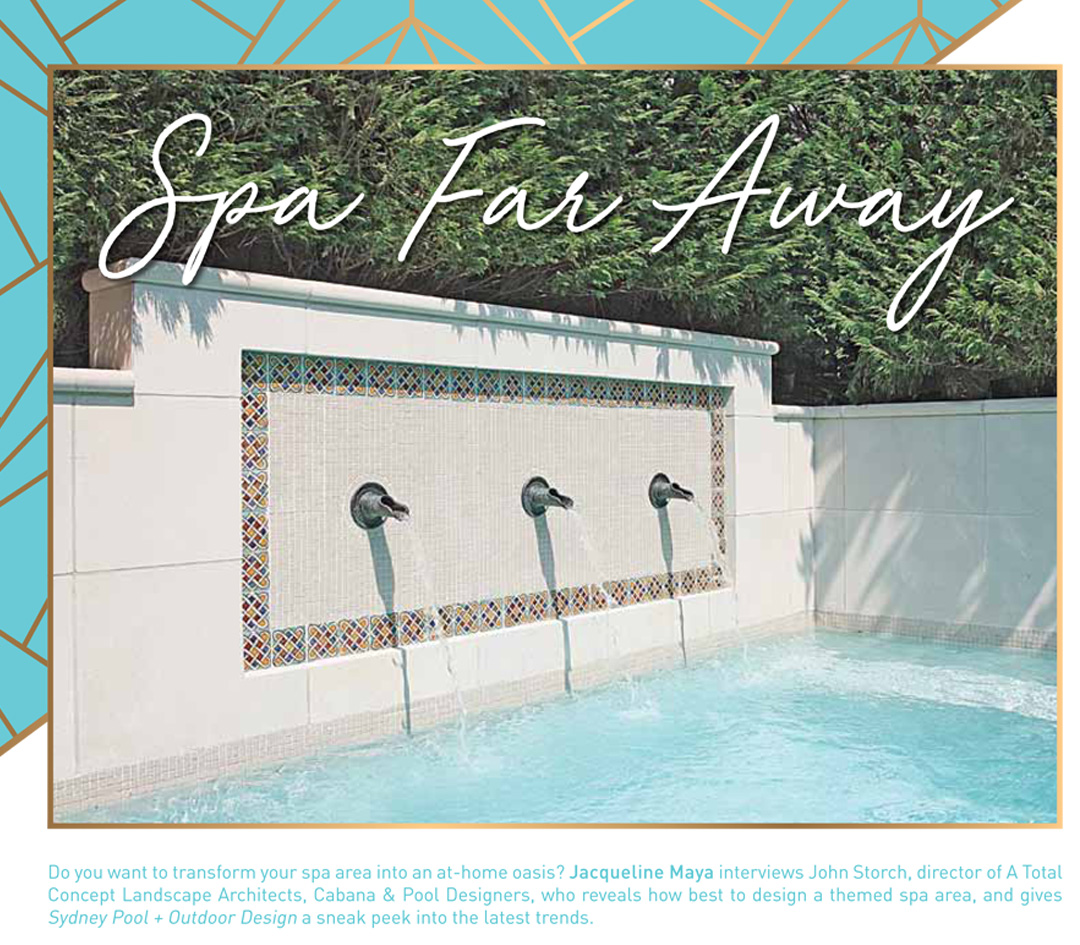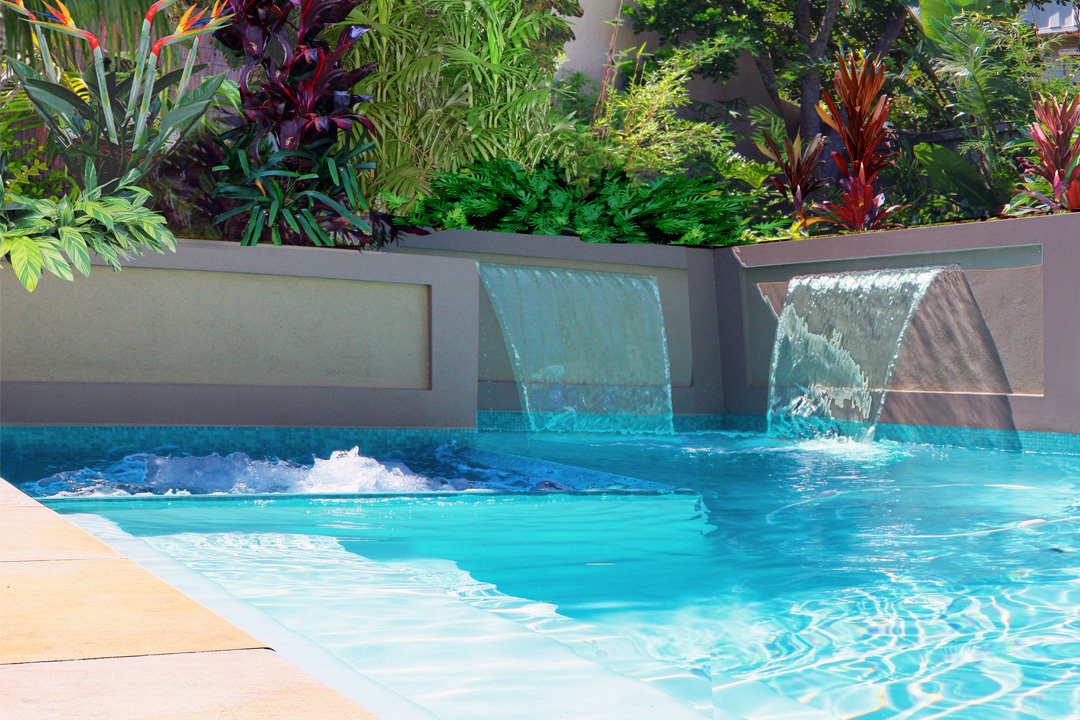
Spa Far Away
Firstly, can you tell us a little bit about your business?
“A Total Concept Landscape Architects, Cabana & Pool Designers is an established award-winning design practice that covers the integration of internal and external areas for a range of projects, from practical family homes and elaborate residential properties, to boutique and resort-style developments. We create a fusion of home and garden areas for our clients. “A Total Concept Landscape Architects, Cabana & Pool Designers provides services that extend from consultations, designs and specifications, council approvals [and] builder recommendations, to the total management of the project and contract administration. We also assist with home alterations and additions, including pools, cabanas and gardens. “A Total Concept Landscape Architects, Cabana & Pool Designers brings together all aspects of the project, and helps you choose the right materials and colours, planting and lighting, internal fixtures and fittings, flooring and paving selections. The team also assists with kitchens, bathrooms and pool equipment. A Total Concepte.
Landscape Architects, Cabana & Pool Designers has more than thirty years of industry experience in helping clients see their dreams come to fruition.”
What kind of spa projects have you worked on?
“We have worked on numerous spa projects, most of which have been fully integrated into the landscape with swimming pools and/or cabanas. It would be rare if we designed a spa in isolation rather than taking into account the entire space or property. “One thing I have noticed is [that parents want] spas that are designed for their homes and integrated with the surrounding entertaining areas. [They want them] not so much for themselves – although everyone loves to relax in a spa after a game of golf – but for their teenage children, so they can be observed rather than out elsewhere, unsupervised.” What are some recent spa design trends that have caught your attention? “With people becoming more educated about the importance and benefits of taking a holistic
entire outdoor projects are gaining popularity. Choosing a comprehensive service makes good design and monetary sense. “If one company handles everything, the finished project will flow better and appear more integrated [through its] consistent design and materials. In addition, this approach allows for better planning of the project, which ensures works are undertaken at the appropriate time, while reducing the costs of reworking areas. “We are finding one of the bigger trends in spa design is their growth both in size and popularity. Spa sizes are growing due to more people living in urban environments. There is also a general trend towards higher-density living, and with tougher authority development controls, private exterior spaces are becoming smaller and more people are expecting these areas to be [fused with indoor] spaces to increase usability. “Plunge spas are often selected by families so they can lie around, get warm, jump in and cool off, and then sit on the long seats and benches to socialise. In winter, plunge spas are heated so

children and adults can comfortably use them. This greatly increases the overall usability of the space, especially with children aged 16 years and over. Plunge spas often incorporate swim jets that allow a swimmer to remain in place while exercising for increased functionality. “Another recent trend has been the resurgence of integrating the spa within the swimming pool. This is achieved by using wet edges to bring the spa’s water level up to the same level as the pool, which allows the water to flow out of the spa under normal filtration, and isolate it when heated. The person in the spa can then choose to drape a hand into the pool to cool off, or be fully immersed.”
Can you give us a rundown of the processes involved for designing a themed spa area?
“We’ll meet with a client to obtain a brief, observe and analyse their property, and discuss how they intend to utilise the spa and surrounding areas. We’ll determine whether it’s for entertaining friends or just family, and how many people will be using the spa. Then we’ll develop a concept for the space and present it to them. “How much money can be spent on the project, and key aspects of design – such as [whether a] pool, kitchenette, or outdoor room will be integrated in the future – are also very important questions to ask. We’ll then meet again to refine the concept [and provide] a finished design that can be competitively tendered.”
What types of features or design elements would you suggest for creating a Japanese-inspired, a tropical-inspired, a Balineseinspired, a Moroccan-inspired, OR an ancient Roman-inspired spa area?
“No matter what style of spa you’re after, the design lines are the most important aspect of the project. The styling of the project is also
extremely important, and can be predominately dictated by the use of [selected] materials. Sculptures of a Balinese goddess or Ganesha
can suggest a type of tropical inspiration. A water feature with hand-made patterned ceramics and terracotta tiles may suggest a Moroccan style, [while] draped-silk roofing or privacy curtains, and a spa interior with Italian glass mosaic tiles may suggest an ancient Roman-inspired design. “A dripping waterfall with lush, exotic foliage can give [the space] a tropical feel. By implementing nature sounds with a Japanese shishi-odoshi ‘deer scarer’ or [a] bamboo water fountain, or by playing traditional Balinese Gamelan bamboos and flute music, you can create a Japanese or Balinese-inspired design, which will help your spa and outdoor area become a restful retreat that drowns out unwanted noise from neighbouring properties. “Mood lighting – which is achieved predominantly by installing dimmable LED lighting – can be bold or subtle, and can be used to draw attention to a styled sculpture, plant or garden feature. It can also create alternating areas of low light and washes of light, which are often used to simulate moonlight or starlight.
Whatever the inspiration for the project, we’d recommend designing the area as a whole. “By simplifying the design process and utilising straight, clean lines rather than complex design shapes, we are finding spa design is becoming less complicated. We’ve been frequently using chunky square edges to create floating effects. We are also creating entertaining and relaxation areas around spas with paving alternatives such as hardwood sleepers and stepping stones. [It takes] thinking outside the square to produce a high-quality product on a budget.”
What spa design elements do you think will be most popular in 2018?
“Bigger and longer benches will be common in the spa, [which] is becoming the social hub of the swimming pool and entertaining area [as it can be] used all year round, including the colder months when the pool is used less often. “Providing more privacy to the spa and its
surrounds [will also be popular]. Whether privacy is provided by screens, masonry walls or greenery, a private spa will encourage more people to use the area.”
What’s your favourite type of spa design?
“I don’t have a favourite spa style or design, but whether it’s a concrete spa or a prefabricated spa, the [most important thing] is to integrate it into the environment, which will make it truly functional, and a place of beauty and respite.”
